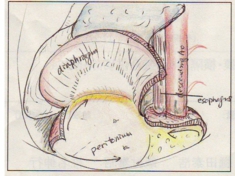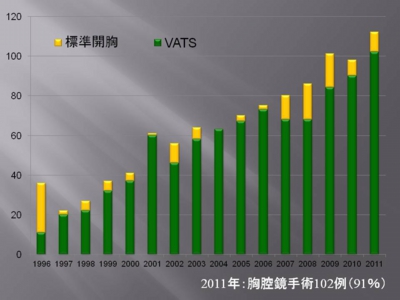What we do
The Hokkaido University Hospital Thoracic Surgery Group provides surgical treatment for all types of thoracic disease. Target diseases in our group include neoplastic lesions such as primary lung cancer, metastatic lung tumor, mediastinal tumors, pleural tumors and chest wall tumors, spontaneous pneumothorax and empyema and surgical treatment of trauma. We conduct a wide range of surgeries including minimally invasive surgeries such as thoracoscopic surgery, pulmonary segmentectomy, complication ablation and extended resection such as bronchoplasty.
About our group
|
|
|
|
Primary lung cancer
 For the surgical treatment for lung cancer, it is necessary to remove all traces of cancer cells, and thus, the basic surgery consists of lobectomy and lymph node dissection. The treatmentstrategy and method vary depending upon the progress and characteristics of the disease. Our treatment policy has the following characteristics;
For the surgical treatment for lung cancer, it is necessary to remove all traces of cancer cells, and thus, the basic surgery consists of lobectomy and lymph node dissection. The treatmentstrategy and method vary depending upon the progress and characteristics of the disease. Our treatment policy has the following characteristics;
- Comprehensive treatment combined with chemotherapy and radiotherapy for cases with lymph node metastasis
- Extended resection in combination with combined resection and tracheobronchoplasty/ angioplasty for cases with infiltration of the surrounding organs.
- About 85% of surgeries for primary lung cancer are performed by VATS, with a completion rate of 80%.
- Standardization of the subject based on the tumor diameter, GGO ratio and PET (SUV value)
- Performing immediate thoracoscopic biopsy and pathological diagnosis during operation for tumor lesions that were not diagnosed prior to surgery.
Three-dimensional reconstruction CT and Simulation surgery
We also analyze details from individual pulmonary vessels and bronchi using three-dimensional reconstruction CT, and apply the results to simulations before the surgery and use it to navigate through the surgery (since marking on the skin poses a risk of dissemination and air embolism, we primarily perform transbronchial marking using a virtual bronchoscopy navigation system in collaboration with The First Department of Medicine).
Metastatic lung tumor

Previously, chemotherapy was the primary choice for the treatment of metastatic lung tumors since it was considered to be a systemic disease. However, it became apparent that local treatment with surgical resection can provide a complete cure if certain conditions are met.
In consideration of possible repeated surgeries, VATS and Hand-assisted VATS are primarily used to preserve lung function to the greatest extent possible. We also actively treat multiple metastatic lesions with surgical treatment combined with radiofrequency ablation in collaboration with the Radiology Department.
Conditions for surgical resection of metastatic lung tumors
- Metastatic lesion shows nodule shadows
- Primary lesions and other legions are completely removed or controlled
- There is no increase in the number of metastatic lesions at follow-up observation after a three month observation period.
- Maintaining respiratory function after lobectomy (regardless of the site; one side, both sides, single site or multiple sites)
Vidoe-assisted Thoracoscopic Surgery VATS
 Number of surgery for malignant lung tumor(VATS vs Open)In the early period starting in 1996, Hokkaido University introduced Video-assisted Thoracoscopic Surgery (VATS) ahead of others in Japan. We are also implementing the Two Windows Method, a surgery conducted through two small incisions, that we have been performing since 2005. It is now possible to perform surgery on elderly patients and patients with complications, who were previously not eligible for surgery, using MICS and VATS. Although applications are limited, we have been accumulating cases in which small children were treated with VATS. We also developed a thin camera system (3mm). We are aiming at performing surgery through the smallest incision in the world.
Number of surgery for malignant lung tumor(VATS vs Open)In the early period starting in 1996, Hokkaido University introduced Video-assisted Thoracoscopic Surgery (VATS) ahead of others in Japan. We are also implementing the Two Windows Method, a surgery conducted through two small incisions, that we have been performing since 2005. It is now possible to perform surgery on elderly patients and patients with complications, who were previously not eligible for surgery, using MICS and VATS. Although applications are limited, we have been accumulating cases in which small children were treated with VATS. We also developed a thin camera system (3mm). We are aiming at performing surgery through the smallest incision in the world.
back


 HOME
HOME
 Read more
Read more
 Read more
Read more
 Read more
Read more













